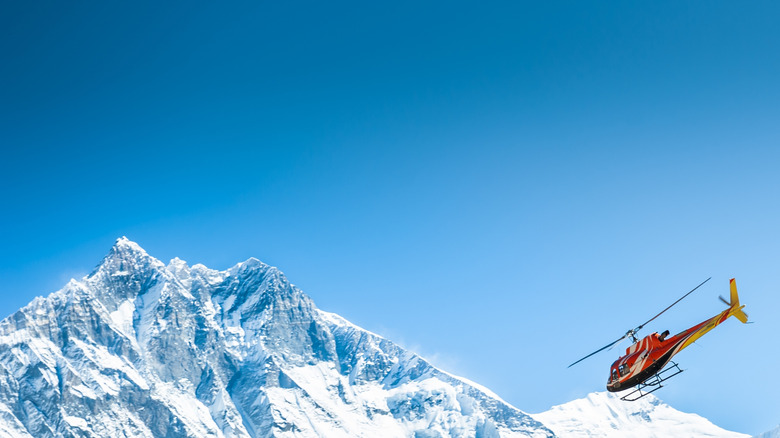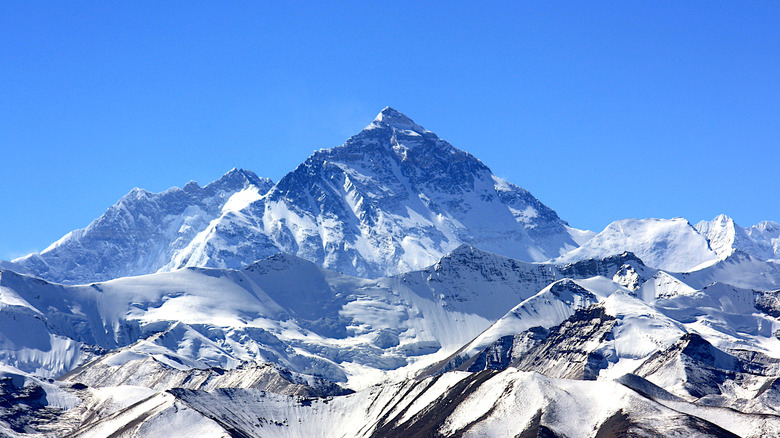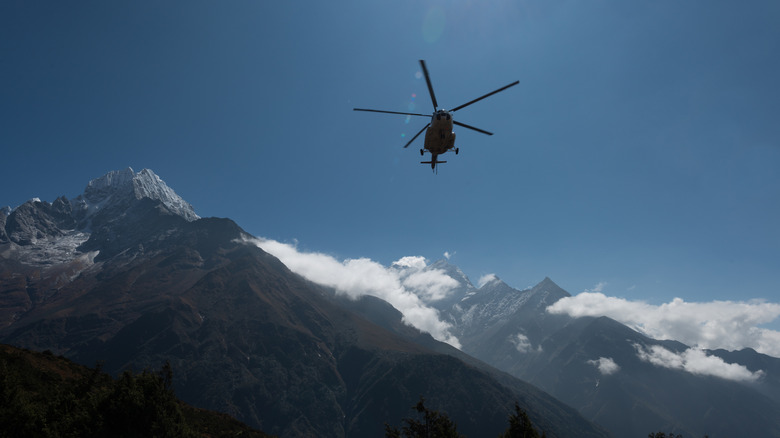How High Can A Helicopter Fly? (And Can It Get To The Top Of Mount Everest?)
In terms of general cruising altitude, the California Aeronautical University reports that a jet airliner will typically cruise at an altitude of up to 42,000 feet. For an Airbus A320 and A321, for instance, cruising altitude is approximately 39,000 feet. By comparison, helicopters generally cruise at approximately 10,000 feet. The world altitude record for helicopter flight was achieved by veteran Squirrel AS350B2 pilot Fred North, who flew the model to 42,500 feet at the International Airport of Cape Town, South Africa, in March 2002. However, North's website does note that "the world record was not monitored nor registered by the Federation Aeronautique Internationale," but it's widely accepted this is the greatest height a helicopter has ever flown at.
With Mount Everest standing at a mighty 29,032 feet high, and with the maneuverability and landing versatility of a helicopter in mind, it is conceivable for a chopper to land on the summit. It has been done, in fact. In May 2005, French pilot Didier Delsalle landed on the top of the mountain in a Eurocopter AS 350 B3. Delsalle's historic landing on Everest's summit went down as the highest helicopter landing ever recorded. Naturally, though, there are huge obstacles to achieving such a feat. The conditions near Everest's peak certainly don't lend themselves to such a journey. The mountain is also officially growing taller, though at a glacial pace.
Developing the confidence to reach the top against the odds
Some of the primary utility of a helicopter lies in its ability to take off and land vertically, by means of its rotor-powered flight. This gives the likes of military helicopters and rescue models the enormous advantage of being able to access landing zones that planes can't.
While it's already very difficult to navigate a helicopter to a pinpoint landing on challenging terrain, the high altitude of Everest is significantly more dangerous. Delsalle, an Airbus Helicopters test pilot, explained to Vertical magazine that it wasn't until the new millennium that his team had confidence in trying such a remarkable landing. Delsalle describes "a kind of personal feeling with my flight test engineer at the time, Bernard Certain, that we had the capability to do that." Such potential would only improve with advanced new engine software for the AS350 B3, which arrived in 2004.
The following year, Delsalle arrived at Lukla — the remote airport used by climbers of Everest — to investigate how to reach the top. "On the updraft side, I wasn't able to approach the mountain because even taking out all of the power of the aircraft, I was still climbing," he said. "On the other side ... even with maybe 60 knots on the airspeed indicator I was going backward." Fortune ultimately favored the brave pilot, who was able to battle the weather effectively to make a landing.
The dangers of Mount Everest rescue efforts
Outside magazine reported that 2023 saw 18 deaths on Everest. The popularity and dangers of the mountain lead many to ask whether helicopter rescue could avert these tragic losses. While it's practically possible to fly to the top of Mount Everest, it's an incredibly perilous journey. As Didier Delsalle put it to Vertical magazine, "is it worth it to risk the life of a pilot and co-pilot to maybe rescue one person at such altitudes? Sometimes maybe it's too dangerous, and you have to accept that it may not be possible."
Also, helicopter flights in the region are heavily restricted. Sagarmatha National Park, where the mountain is situated, is a World Heritage Site, which means that both the local people and natural habitat are of the utmost importance. Frequent helicopter flights in the area are disruptive, with many divided on how best to balance the impact of such flights against tourist income.


